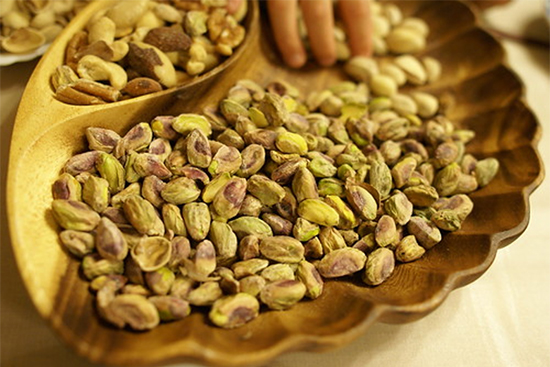 |
Among the pistachio’s nutrients are lutein and zeaxanthin, two antioxidants essential for eye health. Lutein and zeaxanthin have been shown to reduce the chances of developing cataracts and protect against age-related macular degeneration (AMD). They are carotenoids, pigments produced by plants that give fruits and vegetables a yellow to reddish color. The macula contains organic pigment, which is depleted by free radicals (oxidants), formed as a result of external factors like UV exposure, smoking and diets high in fat and sugar, but antioxidants (carotenoids) can build and maintain the thickness of the retinal pigment layer. What’s more, lutein and zeaxanthin help cancel free radicals to maintain healthy vision. The National Eye Institute Age-Related Eye Disease Study (AREDS) showed that antioxidant supplements can reduce the risk of vision loss from advanced AMD by 25 to 30 percent, although less benefit was shown for preventing cataracts. The study also showed that the ability of lutein and zeaxanthin to absorb blue light helps to protect the retina and prevent free radical damage to the macula.
Supplements provide the AREDS recommended amounts of 10 mg lutein and 2 mg zeaxanthin, but dark green vegetables, such as kale, spinach, and broccoli, are excellent sources of lutein and zeaxanthin. Foods like egg yolk, peppers and grapes are good sources, too. However, the average US diet doesn’t meet even half of the recommended values. Raw pistachios contain 1405 μg (micrograms) lutein+zeaxanthin/100 g (1.4 mg/3.5 oz), about thirteen times more than the next highest nut type, hazelnuts, which contain only 92 μg. (Note: Roasted pistachios have excellent nutritional value, too, but they are frequently salted, and too much sodium has negative effects on overall health.)
To summarize, if you’re concerned about your eye health, as we professionals should be, when the big game is on, you can swallow a supplement, cook up some kale, or grab a handful of pistachios. Cracking the shells may also help relieve some anxiety when the score is close!
Learn more about the importance of preventing the acute and chronic effects of UV exposure to the eye with our CE, Closing the UV Protection Gap - Ophthalmic Lens Standards vs. Biological Protection Requirements, at 2020mag.com/ce. This course is free, supported by an educational grant from ZEISS.













